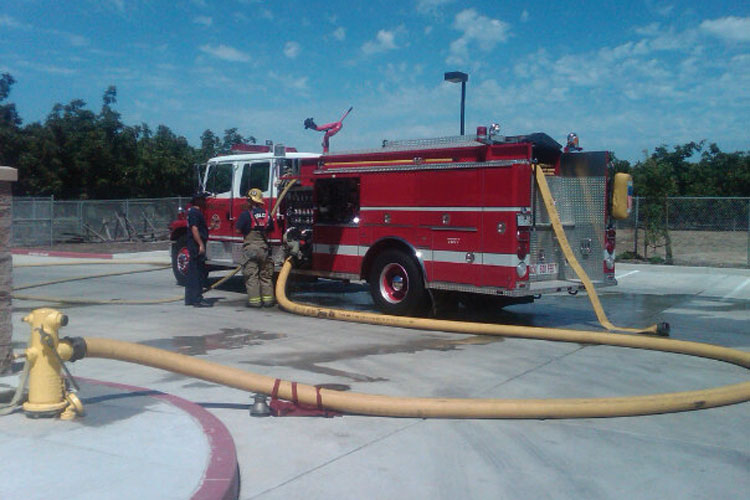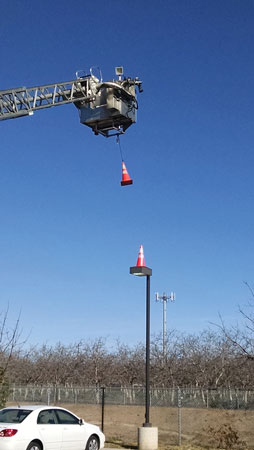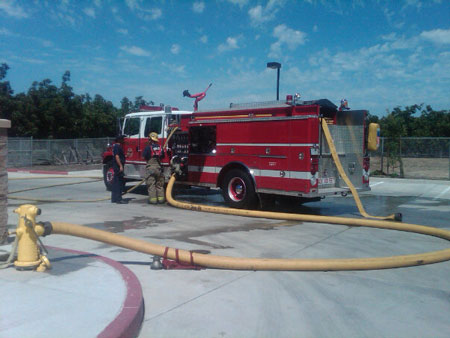
By Eric Hankins
Driver training programs can vary by department. Some may be very comprehensive and regimented; others could be quite basic. But driver training should be a critical part of any fire department’s training program. The position of driver, engineer, operator, chauffeur, or any other title is arguably one of the most important positions in the fire service. Quite simply, without someone to drive the apparatus to the scene of the emergency, the incident cannot be mitigated.
For some departments, the driver might be a rank that was achieved by a formal testing and promotional process. Other drivers may simply be in the seat based on the time of service within the department. Regardless of how your department chooses your drivers, a training program must be developed to ensure your drivers are the best they can be. The litigious nature of the country these days makes appropriate training and documentation necessary.
Establishing a Program
Developing a driver training program can be relatively simple if you break down the components into manageable modules. The modules can be tailored to fit the needs of your department. Some modules may be fairly universal; others may be regional or even unique. Break the modules into sections that last anywhere between 30 minutes and two hours. This will allow departments to use them for short daytime drills or regularly scheduled drill days or combine them into a regimented driver “academy.” Training can be documented in the form of task title sheets that have defined lessons and required or recommended time frames for each learning block. Some blocks may have to be completed prior to moving onto other modules. Your state fire training division may have a program that you can use as a guide.
Module 1: Licensing and State Requirements
The first module, which is universal to every department, involves licensing and state requirements. In some states, a commercial driver’s license is needed to operate fire apparatus; other states may use firefighter endorsements. If a commercial or a special license is required, you will need to develop a module that teaches the students about things such as pretrip inspections, air brake systems, and safe driving practices. Cone courses may be set up to allow the students to maneuver apparatus through obstacles without hitting other vehicles or other hazards.
Once the basic familiarization of the apparatus has been completed, actual drive time is needed. Take the students out during nonemergency times and allow them to drive in traffic. If the vehicle has a manual transmission, use several routes that will help the students gain experience starting and stopping on hills or grades. If possible, newer drivers should start driving in slower, lower-traffic areas to reduce the possibility of accidents.
Emergency driving has risks of its own. Running with lights and sirens (Code 3 in my area) can be risky. Code 3 driving raises anxiety not only in the apparatus driver but also in the other drivers on the street, who will often panic and act in completely unexpected ways. Most states have laws that require other drivers to “pull to the right and stop” when emergency vehicles are approaching. Many motorists go into some sort of vapor lock and slam on their brakes or may try to outrun the emergency vehicle. I have seen people look up at me while I was passing them and shrug their shoulders in a way that says, “I don’t know what I am supposed to do!”
Module 2: Emergency Vehicle Operation Course
The next module would be an Emergency Vehicle Operation Course (EVOC). Many EVOC classes are commercially available. Find one that will work well for you. These courses typically will have premade lesson plans and materials that discuss laws, basic driving rules, defensive driving, and other common hazards. If you chose not to use a commercially available EVOC program, you will need to become familiar with state and federal laws pertaining to emergency vehicle operations – vehicle codes, Code of Federal Regulations, and other areas of personal and departmental liability.
 |
| Flashcards are used to quiz students on hydraulic calculations and total engine discharge pressures. (Art by author.) |
As you can see, up until now, a lot of the emphasis has been on the actual operation of the apparatus. Many of the injuries and fatalities suffered every year in the fire service are the results of apparatus accidents. There is a significant risk in driving large fire apparatus to and from the emergency scene. It is imperative that your drivers become competent and safe in operating your apparatus. If your department has various sizes and types of apparatus, I would recommend starting the newer drivers out on the small, less difficult pieces to build some confidence. Sure, everyone wants to drive the tractor-drawn aerial, but the smaller emergency medical services (EMS) squad or pumper may be a better choice for inexperienced drivers.
Module 3: Pump Theory and Hydraulics
This module, “Pump Theory and Basic Fireground Hydraulics” must take place before pump operations. The students must learn how and why a pump works the way it does before they begin to pump hoselines. Learning about pump theory and hydraulics allows the students to identify and troubleshoot pump problems quickly. Topics may include pump stages, atmospheric pressure, displacement, and troubleshooting. The fire hydraulics module can be combined with the pump theory module, or it may be kept separate. Many departments have predetermined pump pressures established for preconnected lines to eliminate the pump operator from having to do any field hydraulics on bread-and-butter incidents; however, this may do your operators a disservice if they get a fire that is out of the norm and they must figure out the appropriate friction loss for a hoseline.
 |
| (1) Mutual-aid companies may use different thread patterns or hose sizes. Know what adapters are needed before an incident occurs. (Photos by author.) |
Once an accurate field hydraulic formula has been determined and taught to pump operators, you may develop a flash card system with various lines, flows, and elevations to help the students practice the methods and increase proficiency (Figure 1).
Each type of apparatus has different considerations when it comes to spotting and positioning on the fire scene. Ladder trucks typically will need the front of the fire building, and engines may rely on a forward or reverse lay depending on the situation or department policies. Dedicate a good amount of time to positioning the type of apparatus on which the students are working. If using a ladder truck, consider the differences between a mid-mount tower ladder and a rear-mount aerial and the capabilities/limitations of both models.
Module 4: Rural Water Supply Operations
Another module that may be relevant to your program is rural water supply operations. If your department is not covered entirely by a municipal water system, then relay pumping operations or water tender shuttles may be needed to maintain a water supply. Pump or tender operators must train on setting up a nurse tender operation or folding tank type operation. This would necessitate some sort of drafting station. You should also teach students to draft from a static water source. In drafting, emphasize the pump theory element of atmospheric pressure. This is the reason it is important to introduce it early in the training program.
 |
| (2) Stacking cones is a great method the firefighter operating the aerial device can use to practice control. |
Also, if your department responds to high-rise, standpipes, or fire department connections in your area or through mutual/automatic aid to other areas, include a module for pumping these hookups. Some high-rise standpipe systems may require pump pressures as high as 250 to 300 pounds per square inch, depending on the height of the building and whether it has an on-site fire pump. Large box-type stores may have multiple manifolds that supply the fire suppression system inside the building. The students must become familiar with which connections need to be supplied when and at what pressures. Additionally, perhaps neighboring departments have different thread patterns or hose sizes you must adapt to when running incidents with them. You should know what adapters are needed before responding to an incident (photo 1).
Module 5: Off-Road Driving for Wildland Firefighting
Do not overlook this module. Wildland firefighting presents its own set of unique challenges. Often, the drivers must put the apparatus in a position they may not be used to. Driving up and down hills on narrow roads with loose rock can be difficult with a larger piece of fire apparatus. Take out new drivers and teach them how to drive in these situations prior to adding smoke, fire, and radio traffic into the mix. Additionally, sometimes the driver may be driving while a firefighter is walking 15 to 20 feet directly in front of the apparatus for a mobile attack. Discuss proper transmission gear, braking, and communications.
Pumping a wildland hoselay is another challenge. Coefficients for the small forestry type hose will differ from your normal calculations. Adjusting for increase and decrease in elevation and feeding multiple lateral lines off a trunk line will make for some interesting field hydraulics.
 |
| (3) Simple hydraulic and pump operation drills build confidence and develop habit. |
Pumping multiple lines to establish a water supply is a bread-and-butter operation that must be mastered. By placing nozzles on passenger-side discharges, the operator may simulate charging lines and then work to hook the hydrant before running out of tank water. Along with this drill, the operator will work on transitioning from tank water to hydrant supply without overpressurizing the handlines, although today’s electronic pressure governors make this skill somewhat unnecessary.
When operating a ladder truck, strongly consider hazards when positioning and operating the aerial. Power lines are a huge hazard that you must identify when positioning the apparatus and while operating the aerial. Many competent and seasoned operators can “thread the needle” with the aerial when it is needed. This ability on the fireground is gained from training prior to an incident and is the sign of a great truck operator. You can set up several drills quickly and easily to allow the truck operator to set up the aerial and position the bucket or tip in various ways to practice challenging positioning (photo 2).
As the students move through the modules, some parts of the program can be repeated to build the skills. Going out to flow water, for example, will strengthen the students’ pump operating skills and have them review field hydraulics and driver training as well. Setting up the ladder truck to access the roof of a commercial building with the aerial also builds on the basics by combining multiple modules.
Task Sheet
The task sheet given to the students is a great road map for their training. Having the sheet lined out in a natural progression from simple to more comprehensive modules gives them something to aim for. Starting off slowly allows them to build the confidence they will need to operate fire apparatus (photo 3). As the students complete the tasks, the training officer signs and dates the sheets, verifying successful completion of the module. An exam should be given after a module has been completed. Written tests for modules such as pump theory, laws pertaining to emergency vehicle operation, and hydraulic calculations would be appropriate; manipulative testing would be required for modules like cone courses and aerial setup.
Department policy should stipulate whether students need to take a final comprehensive exam or if successful completion of each module is sufficient for operating fire apparatus. Many agencies have a large testing process if the driver position is a structured rank. Regardless of how your department decides to complete the process, one thing is certain: The training cannot stop here. Training in driving and pump or ladder operation must be continual.
As stated before, the liability incurred from driving fire apparatus necessitates that departments maintain a training program and documentation of the training. If a firefighter is involved in any type of accident, these training records will undoubtedly be looked at as evidence.
The road to a structured driver training program does not have to be difficult. There are many examples in place around the country. Finding what works for you and your department and building on these examples will allow you to train your firefighters to become top-notch operators.
Eric Hankins is a captain with the Yuba City (CA) Fire Department and a 24-year veteran of the fire service. He has taught at various fire academies and training courses across the country and has taught at FDIC International for the past five years.
Maximizing Simulation Driver Training
DRIVER TRAINING PROGRAM INCREASES EXPERTISE AND SAFETY
Driver Training Simulators: Strategies and Tactics
Fire Engineering Archives

